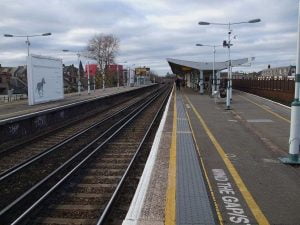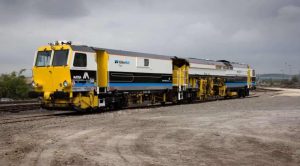The Rail Accident Investigation Branch has released its report after a tamper moved unauthorised into Balham station in South London.
A tamper is a self-propelled piece of track machinery that moves ballast under the sleepers, which hold the track in place.
As around 19:05 on the 20th April 2019, the tamper made an unsignalled and unauthorised move over Balham Junction, which is used by Southern Rail trains in South London, and entered Platform 3 at Balham station.

There was potential for the tamper to hit a passenger train heading through south London. However, the train luckily had traversed the junction 75 seconds earlier.
The tamper stopped in the station – this is where the crew realised it was in the wrong place. There was no damage or injury during this incident.
This incident happened on the boundary of an engineering possession. An engineering possession is where the railway is closed to trains to allow maintenance to take place.
The plans for the train movements out of the possession required the tamper (which was working on the down line in South London) to be crossed over to the up line while still in the engineering possession and to leave the possession on the up line.

This incident happened because the person in charge of possession, or PICOP, provided incomplete information about the position of the tamper. The driver and conductor driver did not query these instructions; neither did the two signallers.
The RAIB has said that the standard of safety-critical communications was poor throughout and resulted in none of the parties having an understanding of the location to the tamper.
Underlying factors were that the supplier which employed the PICOPs had not effectively managed its policy, and that Network Rail’s strategy for improving and maintaining the standard of safety-critical communications within the rail industry has been ineffective.
The RAIB has made four recommendations to Network Rail to make sure that this incident does not happen again:
- The first calls for a review of the company’s strategy for safety-critical communications involving its staff and contractors, to address underlying cultural factors and embed the use of standard communication protocols within the railway industry.
- The second covers a review of the process of handovers between signallers, during and at the end of shifts, to produce a structure which will give the incoming signaller full awareness of all relevant information about the location and intended movement of trains.
- The third recommendation relates to the provision of a suitable working environment for PICOPs, and the fourth to a review of that role, including the competency requirements and ongoing professional management of PICOPs.
- Two learning points relate to the need to test staff involved in safety incidents for drugs and alcohol, and the importance of not using mobile phones while driving road vehicles.
What did the officials say?
Simon French, Chief Inspector of Rail Accidents, said:
Yet again we have investigated an incident in which a poor standard of communications played a crucial part. In this case, the way in which the key individuals talked to each other resulted in a misunderstanding. The consequences of the misunderstanding were that a very large item of yellow plant, a tamping machine, came out of an area where it had been working, onto a line where a passenger train had passed in the opposite direction only a short time before.
The role of person in charge of a possession (PICOP) is an important one. The PICOP controls the movement of trains into, within and out of engineering possessions. There were ten trains working in the possession near Balham, and giving their drivers clear and correct instructions is a vital job. It is not something that should be done from a kitchen table, or while driving a car. PICOPs need to be given adequate facilities for their work, and should make proper use of them.
Our investigation found a culture of poor communications among staff involved with engineering work. People were embarrassed to use the proper protocols when passing messages to colleagues. The aviation industry confronted this problem head-on many years ago, and now any pilot or air traffic controller who does not use the correct form of words and phrases would instantly stand out as less than competent. We found that, while train drivers and signallers have generally achieved a good standard of safety critical communications in recent years, the same cannot be said for engineering operations staff, even when talking to signallers. We are challenging the railway industry to come into line with aviation, and embed the same standards among its people.
In this case several of the people involved did not challenge information or instructions which were confusing, inconsistent with what they had just been told by someone else, or contrary to rules. This is not the first time this has led to trouble, and the consequences can be disastrous. In the collision between two engineering trains in a possession at Logan in 2015, a locomotive and eighteen wagons were derailed and damaged. That accident also arose from a misunderstanding created by poor communications report 13/2016, and we have investigated other collisions in possessions at Badminton report 30/2007, Leigh on Sea report 24/2009, Arley report 12/2013 and Kitchen Hill bulletin B1/2014.
These are all areas in which the industry has previously made efforts to improve, but for whatever reason, lasting change has not happened. I hope that this time implementation of our recommendations will make a real difference.
Where Next?
RailAdvent Plus
Pictures, prints and streaming video!
News Homepage
For the Latest Railway News
RailAdvent Online Shop
Framed Prints, DVD’s/Blu-Ray’s and more
LocoStop Community
Come and share your railway pictures
Mainline Steam Info
Upcoming mainline steam tours/loco movements
RAIB
Visit their website






Responses
At the advent of the first formal driver training programme in 1977, known as the MP12 structure, the first thing emphasised was the ABC of communication: Accurate, Brief, Concise. Nothing has changed; why, then, do erstwhile responsible people working the railway still get this so badly wrong? Lack of experience and the professionalism that comes from it? Lack of monitoring of splinter companies by NR? I think it is “get a grip” time.